Related Research Articles
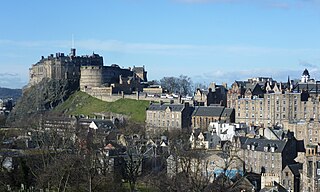
Edinburgh Castle is a historic castle in Edinburgh, Scotland. It stands on Castle Rock, which has been occupied by humans since at least the Iron Age. There has been a royal castle on the rock since the reign of Malcolm III in the 11th century, and the castle continued to be a royal residence until 1633. From the 15th century, the castle's residential role declined, and by the 17th century it was principally used as a military garrison. Its importance as a part of Scotland's national heritage was recognised increasingly from the early 19th century onwards, and various restoration programmes have been carried out over the past century and a half.

Stirling Castle, located in Stirling, is one of the largest and most historically and architecturally important castles in Scotland. The castle sits atop an intrusive crag, which forms part of the Stirling Sill geological formation. It is surrounded on three sides by steep cliffs, giving it a strong defensive position. Its strategic location, guarding what was, until the 1890s, the farthest downstream crossing of the River Forth, has made it an important fortification in the region from the earliest times.
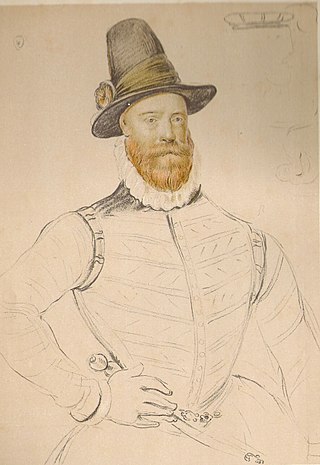
James Douglas, 4th Earl of Morton was a Scottish nobleman. He played a leading role in the murders of Queen Mary's confidant, David Rizzio, and king consort Henry Darnley. He was the last of the four regents of Scotland during the minority of James VI. He was in some ways the most successful of the four since he won the civil war that had been dragging on with the supporters of the exiled Mary, Queen of Scots. However, he came to an unfortunate end, executed by means of the Maiden, a predecessor of the guillotine.
Broughty Castle is a historic castle on the banks of the River Tay in Broughty Ferry, Dundee, Scotland. It was completed around 1495, although the site was earlier fortified in 1454, when George Douglas, 4th Earl of Angus, received permission to build on the site. His son, Archibald Douglas, 5th Earl of Angus, was coerced into ceding the castle to the crown. The main tower house forming the centre of the castle with four floors was built by Andrew, 2nd Lord Gray, who was granted the castle in 1490.

Castles are buildings that combine fortifications and residence, and many were built within the borders of modern Scotland. They arrived in Scotland with the introduction of feudalism in the twelfth century. Initially these were wooden motte-and-bailey constructions, but many were replaced by stone castles with a high curtain wall. During the Wars of Independence, Robert the Bruce pursued a policy of castle slighting. In the Late Middle Ages, new castles were built, some on a grander scale as "livery and maintenance" castles that could support a large garrison. Gunpowder weaponry led to the use of gun ports, platforms to mount guns and walls adapted to resist bombardment.

David Leslie, 1st Lord Newark was a Scottish military officer and peer. During the Thirty Years' War, he joined in the Swedish Army in 1630 and served under Alexander Leslie. Returning to Scotland in the final days of the Bishops' War, Leslie fought in the English Civil War and Scottish Civil Wars on the side of the Covenanters and Royalists. After the Stuart Restoration, Leslie was raised to the peerage of Scotland as Lord Newark by Charles II of Scotland.
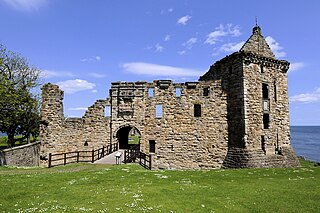
St Andrews Castle is a ruin located in the coastal Royal Burgh of St Andrews in Fife, Scotland. The castle sits on a rocky promontory overlooking a small beach called Castle Sands and the adjoining North Sea. There has been a castle standing at the site since the times of Bishop Roger (1189–1202), son of the Earl of Leicester. It housed the burgh’s wealthy and powerful bishops while St Andrews served as the ecclesiastical centre of Scotland during the years before the Protestant Reformation. In their Latin charters, the Archbishops of St Andrews wrote of the castle as their palace, signing, "apud Palatium nostrum."

Dumbarton Castle has the longest recorded history of any stronghold in Scotland. It sits on a volcanic plug of basalt known as Dumbarton Rock which is 240 feet (73 m) high and overlooks the Scottish town of Dumbarton.

Henry Stewart, 1st Lord Methven was Master of the Scottish Artillery and third, and last husband, of Margaret Tudor, eldest daughter of Henry VII of England and Elizabeth of York.
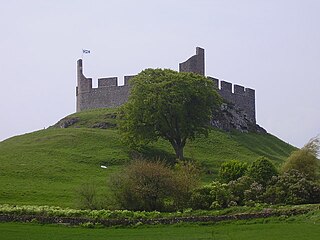
Hume Castle is the heavily modified remnants of a late 12th- or early 13th-century castle of enceinte held by the powerful Hume or Home family, Wardens of the Eastern March who became successively the Lords Home and the Earls of Home. The village of Hume is located between Greenlaw and Kelso, two miles north of the village of Stichill, in Berwickshire, Scotland.. It is a Scheduled Ancient Monument, recorded as such by Historic Environment Scotland.
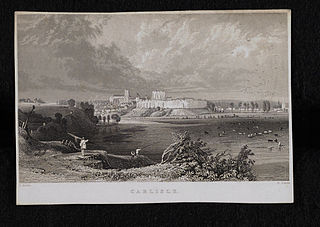
The siege of Carlisle took place from 21 to 30 December during the Jacobite rising of 1745, when a Jacobite garrison surrendered to government forces led by the Duke of Cumberland.
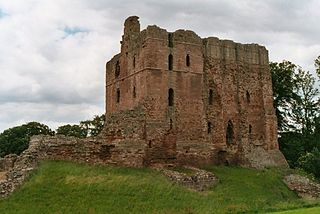
Norham Castle is a castle in Norham, Northumberland, England, overlooking the River Tweed, on the border between England and Scotland. It is a Grade I listed building and a Scheduled Ancient Monument. The castle saw much action during the wars between England and Scotland.

The capture of Roxburgh was a siege that took place during the Anglo-Scottish Wars. Following the Second War of Scottish Independence intermittent conflict continued along the Anglo-Scottish border with Roxburgh Castle being held by the English since 1346 and by the 1380s was one of the last English held strongholds in Scotland. In July 1460 James II of Scotland began a campaign to reclaim Roxburgh, aiming to take advantage of the fact that the Wars of the Roses were raging in England.

Sir William Oliphant, Lord of Aberdalgie and Dupplin, was a Scottish magnate, knight and leader during the Wars of Scottish Independence.

The siege of St Andrews Castle (1546–1547) followed the killing of Cardinal David Beaton by a group of Protestants at St Andrews Castle. They remained in the castle and were besieged by the Governor of Scotland, Regent Arran. However, over 18 months the Scottish besieging forces made little impact, and the Castle finally surrendered to a French naval force after artillery bombardment. The Protestant garrison, including the preacher John Knox, were taken to France and used as galley slaves.
Sir William Oliphant, was a Scottish knight and Governor of Stirling Castle during the Wars of Scottish Independence. He switched loyalties to the English and died in a Scottish prison.

The Marian civil war in Scotland (1568–1573) was a period of conflict which followed the abdication of Mary, Queen of Scots, and her escape from Lochleven Castle in May 1568. Those who ruled in the name of her infant son James VI fought against the supporters of the Queen, who was exiled in England. Edinburgh Castle, which was garrisoned in her name, became the focus of the conflict and surrendered only after an English intervention in May 1573. The conflict in 1570 was called an "internecine war in the bowels of this commonwealth", and the period was called soon after an "internecine war driven by questions against authority."

Wark on Tweed Castle, sometimes referred to as Carham Castle, is a ruined motte-and-bailey castle at the West end of Wark on Tweed in Northumberland. The ruins are a Grade II* listed building.

The siege of Stirling Castle took place from 8 January to 1 February 1746, during the 1745 Rising, when a Jacobite force besieged Stirling Castle, held by a government garrison under William Blakeney.
Colonel John Cockburn was an officer in the Scottish Covenanter army in the late 1640s and early 1650s during the Wars of the Three Kingdoms. In this capacity he led Lowland soldiers against Montrose's Scottish Royalist forces during the First English Civil War (1642-1646), when the Covenanter parliament of Scotland was allied with the English Parliamentarians against King Charles I. Colonel Cockburn led the colourfully defiant but futile Scottish resistance at Hume Castle during the Third English Civil War (1649-1651), when a Parliamentary army led by Oliver Cromwell invaded Scotland after its Covenanter government had made an uneasy alliance with King Charles II.
References
- ↑ Alexander Courtney, James VI, Britannic Prince: King of Scots and Elizabeth's Heir, 1566–1603 (Routledge, 2024), pp. 25, 72, 83–86.